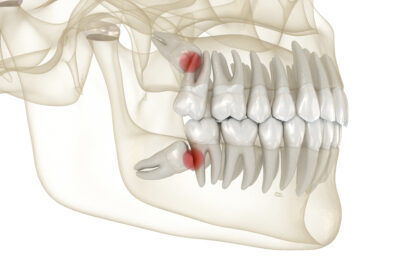We get it. When compared to life-threatening illnesses, gum disease just doesn’t seem like that big of a deal. Perhaps it’s the fact that gum disease doesn’t have any painful or gruesome symptoms until it reaches a later stage. Maybe it’s that we don’t rank our gums high on the list of “very important body parts.” However, over half of the American population has gum disease and in addition to holding the top-spot for causes of adult tooth loss, gum disease has been linked to an increased risk for heart disease, arthritis, diabetes, and respiratory illness. Today, we’re taking a brief tour of how gum disease progresses and touching on some common treatment options.
Bad Beginnings
Gum disease starts when plaque builds up at the gum line. Plaque is comprised of several substances, namely colonies of bacteria that adhere to each other and to any available oral surfaces. If plaque is not regularly removed via brushing and flossing, it will calcify (and calcified plaque can only be removed through a professional cleaning). From there, gum disease progresses in a predictable series of events:
Gingivitis
Bacteria in the plaque feed on sugar particles in the mouth and excrete acids. The acids irritate the soft gum tissues, causing them to look red and inflamed and bleed easily when poked or brushed. At this stage, gum disease is referred to as gingivitis. Gingivitis can usually be treated at home using careful oral hygiene and prescription mouthwash containing chlorhexadine.
Periodontitis
The body senses the presence of bacteria and responds by becoming inflamed and causing the gums to recede from the teeth. As the gums recede, they create troughs referred to as “periodontal pockets,” in which more plaque, bacteria, and food particles can accumulate and bring about infection. Once the depth of these pockets reaches 3mm, the condition qualifies a full blown gum disease or periodontitis. For the most part, dentists recommend root planing and scaling in addition to more frequent professional cleanings to treat this stage.
Severe Periodontitis
The body senses the infection and responds by destroying the gum tissue, connective tissue, and alveolar bone that holds the tooth in place. The gums recede further and begin to look extremely unhealthy, the breath takes on a characteristic foul odor, and the teeth loosen in their sockets. Called severe periodontitis, this stage results in tooth loss and, in many cases, bone loss in the jaw. Any bone loss will need to be corrected via bone grafting and the teeth should be replaced with dental implants, bridgework, or dentures.
About Shawn Hofkes, DDS
With advanced training in oral and maxillofacial surgery, Shawn Hofkes, DDS is qualified to provide comfortable, advanced gum disease treatments from our state-of-the-art dentist office in Cerritos, CA. To schedule your appointment or consultation with Dr. Hofkes, contact us today. We proudly serve patients of all ages from Cerritos, Lakewood, Long Beach, Buena Park, and all surrounding communities.














